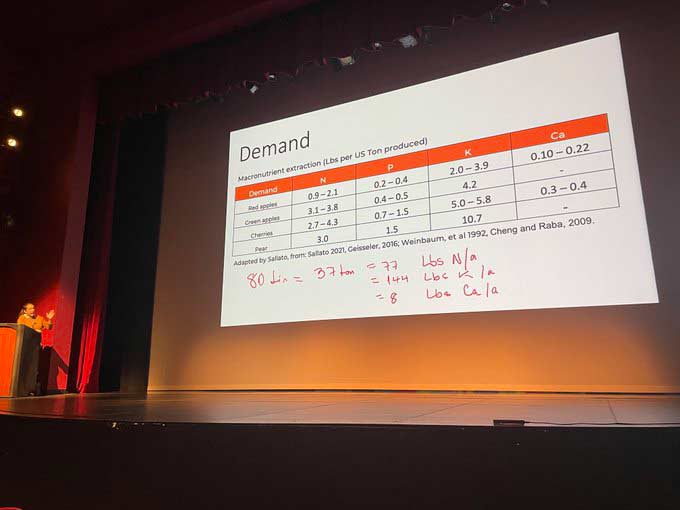
For the second day of the Washington State Tree Fruit Association’s annual meeting in Wenatchee, on Dec. 6, scientists went deep into soil health, nutrient management, rootstock selection and how cover crops and soil amendments can impact tree performance.
There’s more to nutrient management than nutrient application, said Washington State University Extension specialist Bernardita Sallato.
She shared data showing that calcium deficiencies are extremely rare in Washington orchard soils, yet growers struggle with calcium-related disorders such as bitter pit.
It’s a complex disorder, but soils with an excess of potassium — which is quite common — can compete with that calcium for uptake, she said. In other cases, “the problem is there are no roots,” she said. “You have to dig a pit and look at the profile of your soils.”
Continuing on the theme of bitter pit, WSU physiologist Lee Kalcsits spoke about the relationship between tree vigor, biennial bearing, crop load, nutrient balance and bitter pit. Lower crop loads and higher vigor results in larger fruit and less calcium in the fruit relative to potassium and magnesium, two factors associated with bitter pit development. Careful rootstock choice can help growers manage those problems.
“Rootstocks can be a tool to even out that biennial cycling,” he said. “Don’t just take what (rootstocks are) available, make sure you are getting what fits your site and scion needs.”
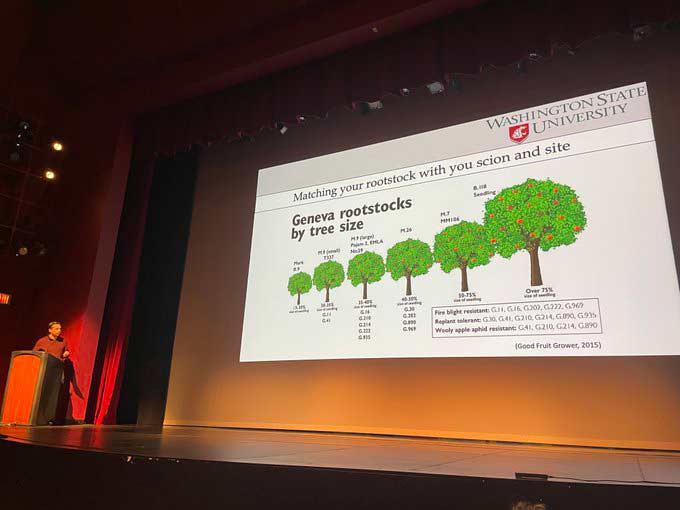
University of Wisconsin associate professor Amaya Atucha shared findings from a long-term study into the relationship between orchard floor management and tree growth and production, conducted at Cornell University where she did her graduate studies.
The last speaker was geneticist Amit Dhingra.
What’s a geneticist doing in a soil session, you ask? Dhingra explained how he got connected to research into biochar as a soil amendment while at WSU. (He recently joined the faculty at Texas A&M University.)
“We really want to see, when someone says a soil amendment works, what does that mean?” he said. Modern genetic tools can help to answer that question, as you see how a plant’s gene expression changes in response to amendment application.
In experiments applying biochar to field-grown tomatoes, his research group found some very different patterns of gene expression and differences in the soil microbial community.
“We are just scratching the surface with this data,” he said.
In September, the clean plant propagation company Dhingra founded, NuPhy, acquired a biochar company and renamed itself Qualterra.
The business of ag

The business track session featured talks on outside investment, labor regulations, implementation of new food safety rules for irrigation water, and leadership strategies. A panel discussion of equity investment in the fruit industry highlighted that track.
Jared England of Manson Growers led a panel with accountant Kelli Visser, investment banker Scott Porter and Chris McCarthy of Auvil Fruit discussing the pros and cons of outside money propping up the fruit industry and taking it to new heights.
Manson and Auvil both recently took on outside investors and lauded the process, even though decisions were tough.
McCarthy said the 2019 deal helped the company weather 2020 COVID-19 restrictions, the 2021 heat dome and the 2022 cold pollination season. The investors do not try to tell farmers how to farm, he said, but they have provided some outside-the-box expertise and advice from their dealings with other industries.
Porter was optimistic about the future of outside investment, but he admitted it would create “winners and losers” by raising the bar of excellence and efficiency for the industry. There is room for larger and smaller producers, but the trend is toward vertically integrated companies.
Visser reassured growers, even small ones, there is room for them in this investment space, and they get to call a lot of the shots in the deal-making.
“Don’t be intimidated by this,” Visser said.
As for food safety, the U.S. Food and Drug Administration is moving toward a systems approach for ensuring water safety, instead of just mandating tests as the sole measuring stick, said Donna Clements of the Produce Safety Alliance, which has developed the curriculum for food safety rules.
As for regulations, rules about prevailing wages and the Adverse Effect Wage Rate, or AEWR, are changing rapidly, and some are under legal challenge.
Meanwhile, staff from the Western Regional Agricultural Stress Assistance Program’s farmer suicide prevention program said taboos around mental health are softening. Farmers and workers are seeking their help now, said Julie Jesmer.
Female farmers report a higher level of stress on baseline surveys than male farmers, Jesmer said. However, male farmers die by suicide at a higher rate compared to the male population at large, while for female farmers the trend is the opposite.
Afternoon potpourri
A hodgepodge of ideas made up the afternoon sessions.
The annual Research News Flash updates covered everything from pest management to heat mitigation and ozone applications to pollination.
Two grower panels discussed industry problems and some of the solutions. Technology adoption in the form of robotics and decision-aid apps were among the suggestions, but so was collaboration.
And 20-year-old Kait Thornton of Tonasket told growers how she has branded herself as a media influencer as she pursues her marketing degree from Washington State University. In short, social media is not all evil or frivolous. She shared examples of how she has swayed public opinion just a little through online conversations.
She urged growers to tap their kids and grandkids to help them tell their stories online, from the heartache of an ill-timed hailstorm to the thrill of a good packout.
“It’s honestly selfish if we keep that to ourselves,” she said.
—by Kate Prengaman and Ross Courtney

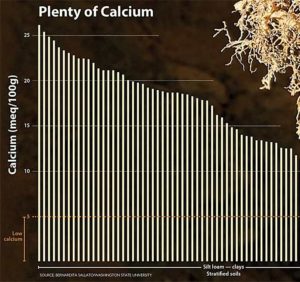
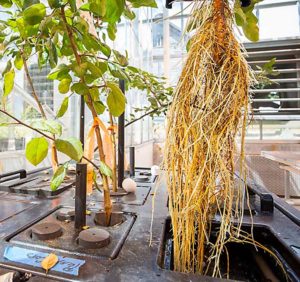
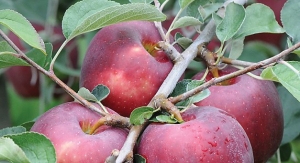





Leave A Comment